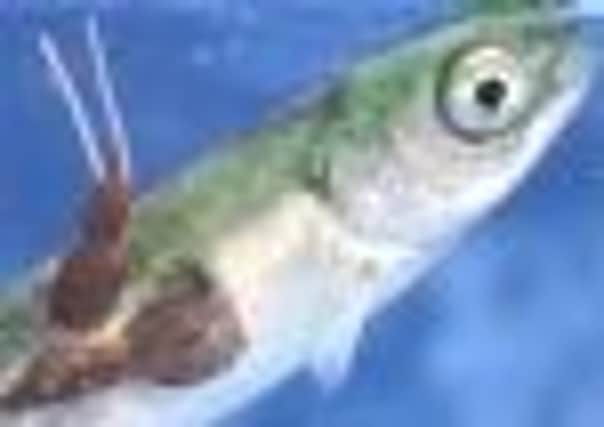Scientists create the ‘armour-plated’ salmon


For the first time, thousands of young salmon – smolts – harvested from the wild but then reared in fish pens are being doused with a chemical treatment that prevents them being attacked by harmful sea lice at the start of their journey to the open ocean.
A three-year experiment has found that as a result of the treatment, more mature fish are returning to their home Scottish rivers in a significant boost to the local economy. Rod catches on the River Lochy, near Fort William, have risen by 10 per cent - an extra 400 fish - an indicator that greater numbers of salmon are returning. On the Carron, in Wester Ross, another river hit by declining numbers, stocks are said to have staged a “phenomenal recovery”.
Advertisement
Hide AdAdvertisement
Hide AdUp to 100,000 treated smolts are now to be released over the next three years to build on the success of the trial. A successful outcome will help to remove one of the major barriers to expansion of the fish farming industry on the west coast. Growth of the industry which brings jobs and money into remote rural locations has been severely hampered by evidence that sea lice infestation of farmed salmon in west coast lochs and rivers has damaged wild stocks.
The new technique protects the wild smolts which have to swim past fish farm cages from infestation with the sea lice often found on the farmed variety. Jon Gibb, the manager of a wild fish hatchery on the River Lochy in Inverness-shire, said the trial arose from a collaboration between wild fish and industry interests. Wild salmon fry he collected were raised in Marine Harvest pens before being treated with an anti-sea lice medicine provided by pharmaceuticals company Merck. He said: “Two weeks later, mingling with their truly wild brethren, the little treated smolts exit the river on their seaward journey – a veritable army of armour-plated young travellers.”
The problem of sea lice killing smolts has bitterly divided salmon farmers and campaigners fighting to save wild salmon stocks. The latter maintain that fish bred in cages near salmon rivers are spreading parasites, causing a decline of wild salmon, while leaders of Scotland’s fish farming industry say the complaints are ill-informed and overstated.
Gibb believes the results of the trial could lead to a new era of co-operation between fish farmers and wild fish interests that could allow a major expansion of the industry, bringing extra jobs. Writing in Scottish Field magazine, Gibb said the breakthrough was only possible by working in partnership with some of salmon farming’s biggest names – Marine Harvest, EWOS feeds and Merck International.
His role was to hand over indigenous fry from wild Lochy broodstock to farmers to be reared on to the smolt stage in pens with the right feed, and then treating the fish with an anti-sea lice medicine called SLICE.
This treatment affords them six weeks immunity to the parasites, enough time to swim out past any salmon farms which could threaten infestation, and into the sea.
Gibb said: “The idea is that these fish return to the river and they not only boost the fishery potential, with the hotels, the pubs and garages that benefit from the spin-offs, but it also adds to the long-term survival of the river. You have to think that for every adult female that comes back, it’s carrying about 5,000 eggs with it, so that is boosting the future for the river. It’s restoration and enhancement at the same time and we are so encouraged by these trial results that the programme will now move into full production.”
The fish farming industry is already a major export earner for Scotland – producing around 150,000 tonnes per year – but the Scottish Government announced recently that it wanted to double production to meet new Chinese demand. Gibb added: “It is fairly early days, but I am utterly convinced, as a manager of the largest west coast salmon fishery, that this is the way forward for a few rivers on the west coast. If you can mitigate against the impact of the farm, then it has a better future and all the jobs stay.”
Advertisement
Hide AdAdvertisement
Hide AdA spokesman for the Scottish Salmon Producers’ Organisation, which represents 98 per cent of salmon farmers in Scotland, said: “The pioneering approach in the Lochy shows what is possible through collaboration.”
But Guy Linley-Adams, who heads the Salmon and Trout Association’s campaign to protect wild salmon, said Gibb’s solution did not address the core problem that faced the industry.
He said: “I think the question you have to ask is why the fish farms want to fund this sort of work? They realise that fish farms, particularly those in inappropriate places at the mouths of wild salmon rivers, are very likely to be having an effect on wild smolt leaving the river for the first time and swimming past lice.”
He said fish farms were looking for ways to avoid being forced to move farms or change their methods, and the SLICE treatment fitted this aim.
Gibb agreed inappropriately sited fish farms should be moved, but said that there had to be “pragmatic and realistic” evaluation about what could be achieved in relation to the economics of the industry.